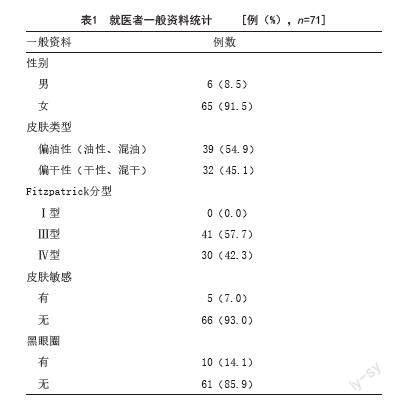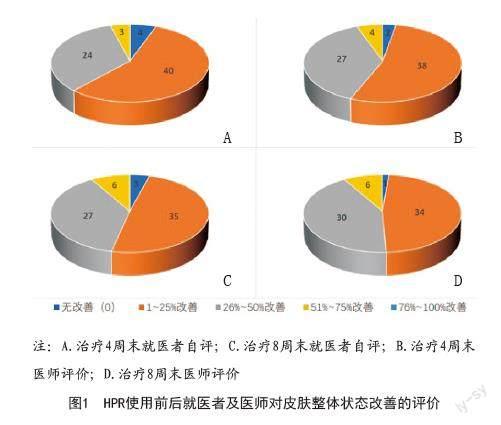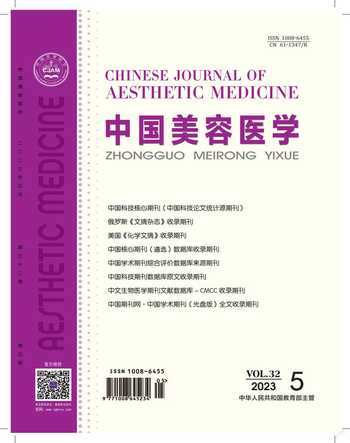以羟基频哪酮视黄酸酯(HPR)为主的护肤品改善皮肤早期老化征象的回顾性研究
2023-06-23赵慧敏赵志祥王雅玲黄紫扬简丹
赵慧敏 赵志祥 王雅玲 黄紫扬 简丹



[摘要]目的:探究以羟基频哪酮视黄酸酯(Hydroxypina retinoate,HPR)为主要成分的非处方维A酸类护肤品在临床上改善皮肤早期老化征象的有效性及安全性。方法:对72例使用以HPR为主要成分护肤品的早期老化就医者进行回顾性研究。结果:使用4周后,44%的就医者皮肤整体改善度在25%以上,其中肤色、纹理、皱纹、毛孔较使用前有显著性改善(P<0.01),并在使用8周后持续改善,且就医者耐受性良好,常见的副作用为短暂性的轻度干燥、刺痛、红斑。结论:以HPR为主要成分的护肤品对于皮肤早期老化征象具有明确改善作用,主要体现在肤色、纹理、皱纹的改善,其副作用相对可控。
[关键词]维A酸;羟基频哪酮视黄酸酯;皮肤老化;肤色;纹理;皱纹
[中图分类号]R758.4+2 [文献标志码]A [文章编号]1008-6455(2023)05-0010-05
A Retrospective Study on the Improvement Of Early Aging Signs of Skin by Skin Care Products Based on Hydroxypinacone Retinoate
ZHAO Huimin,ZHAO Zhixiang,WANG Yaling,HUANG Ziyang,JIAN Dan
(Department of Dermatology,Xiangya Hospital,Central South University,Changsha 410008,Hunan,China)
Abstract: Objective To explore the efficacy and safety of over-the-counter retinoic acid skincare products with hydroxypinone retinoate as the main component in improving the early aging signs of skin. Methods A retrospective study was conducted on 72 early aging patients who used skin care products with HPR as the main component. Results After 4 weeks of use, 44% of the patients had an overall skin improvement of more than 25%, in which the skin color, texture, wrinkles and pores were significantly improved compared with those before use (P<0.01), and continued to improve after 8 weeks of use, and the patients had good tolerance. The common side effects were transient mild dryness, tingling and erythema. Conclusion We preliminarily believe that the skin care products with HPR as the main component have a clear improvement effect on the early aging signs of skin, mainly reflected in the improvement of skin color, texture and wrinkles, and the side effects are relatively controllable.
Keywords: retinoic acid; hydroxypinacone retinoate; skin aging; skin colour; texture; wrinkle
皮膚衰老作为系统性衰老的早期提示性指标[1],在衰老领域中一直受到研究者的重视。除了自然衰老以外,如何减缓皮肤老化也是皮肤科医生和皮肤护肤品研发者所关注的问题。皮肤早期老化表现为皱纹、肤色暗沉、视觉和触觉粗糙度增加(纹理改变、毛孔粗大)等[2]。早在20世纪80年代,就有研究证实外用维A酸软膏可改善皮肤老化[3-4]。在抗老化外用制剂的研究中,大量的研究发现局部使用维A酸类药物对减少老化损伤具有积极作用[5];但其刺激性反应[6]如红斑、刺痛、灼热等限制了维A酸的广泛应用。因此在抗老化外用制剂的研究中,研究者开发多种维A酸的衍生物,如视黄醇、视黄醛、视黄酸等,其中视黄醇被认为是减缓衰老过程最有效的物质之一[7],这些衍生物虽然在一定程度上减轻了维A酸的刺激性[8],但也不可避免地降低了维A酸的疗效。研究表明,在同一浓度下,视黄醇改善皮肤老化的能力约比维A酸低10倍[9];并且仍存在稳定性差[6]的缺点。鉴于上述问题,有研究者将维A酸进行包裹[10-11]或将维A酸衍生物与其他抗老化成分[12-13]组合成复合护肤产品来减少维A酸的刺激性,增加其稳定性,同时增强其有效性。由于维A酸类护肤品的改进技术各有不同,进一步的临床试验验证其效果的差异性有一定指导意义。此外,有文献显示[14],九项针对不同维A酸类非处方护肤品的随机、双盲、载体对照临床试验中,四项试验报道了含视黄醇的治疗方法与载体在改善老化方面没有统计学上的显着差异;仅五项试验证明视黄醇可能仅对面部皮肤细纹有轻微的改善作用,这提示,有必要针对某一类产品进行更加规范的临床观察。羟基频哪酮视黄酸酯(HPR)作为一种较为新型的维A酸衍生物,是通过频那醇修饰视黄酸活性基团得到的。HPR作为新一代的维A酸类衍生物,被认为在稳定性、安全性和有效性方面较之前的衍生物更具优势。本研究就既往数据回顾性分析,研究以HPR为主要成分的非处方维A酸类护肤品在临床上应用的有效性及安全性,以期为后期进行相关双盲前瞻性实验提供基础研究数据。
1 资料和方法
1.1 一般资料:本研究收集了中南大学湘雅医院皮肤科门诊2021年1月-2021年12月以改善皮肤早期老化为诉求的71例就医者为研究对象,男女不限。见表1。本研究经中南大学湘雅医院伦理委员会批准,获取所有就医者知情同意。
1.2 纳入标准:①已经使用以HPR为主要成分的护肤品8周及以上并存在4周末及8周末回访照片者;②就医者同意相关研究者查看、使用其照片及其他资料并能接受电话或其他形式的回访。
1.3 排除标准:①已知对该种护肤品的任何成分过敏者;②在1个月内使用另一种试验药物治疗或计划参加另一项临床试验者;③入组前3个月面部激光治疗者;④入组前1个月使用其他美白、除皱、淡斑等产品者;⑤孕妇或哺乳期女性。
1.4 研究方法:就医者早晚洁面后均使用以HPR为主要成分的护肤品(仙瑟A醇冻龄精华,山东烟台仙瑟商贸有限公司,批号:YY40LK245,以下简称HPR)与基础保湿霜护肤。由2名工作年限5年以上皮肤科主治医师分别在就医者使用HPR后4周、8周末,根据VISIA皮肤检测仪(Canfield Scientific,Fairfield,NJ, USA)及皮肤镜(ARAM HUVIS Co., Ltd. Korea)记录数据,评估皮肤老化的改善情况。基线情况设为1,每减少0.1代表較基线改善10%,反之,每增加0.1代表较前加重10%。0即无改善;1%~25%即轻度改善;26%~50%即中度改善;51%~75%即明显改善;>75%即显著改善。
1.5 观察指标:主要观察指标是面部皮肤整体改善情况以及肤色、纹理、皱纹、毛孔的改善程度。次要观察指标为评估受试者在使用HPR 4周、8周后皮肤敏感性、黑眼圈的变化以及就医者对皮肤整体状态改善的评估。
1.6 不良反应:于使用HPR 4周、8周时进行不良反应记录,询问就医者是否出现干燥、红斑、刺痛、瘙痒等症状并记录持续时间及相关处理措施。
1.7 统计学分析:采用SPSS 25.0统计软件对资料进行数据分析,就医者使用HPR前后相关数据,若符合正态性检验,则两者比较采用配对t检验,若不符合正态性检验,则两者比较采用配对秩和检验。P<0.05为差异有统计学意义。
2 结果
2.1 皮肤改善度:本研究共纳入71例Fitzpatrick分型为Ⅲ~Ⅳ型的就医者,在使用HPR 4周后,医师对皮肤整体状态的改善程度进行评估,结果表明,38%和6%的就医者分别有25%~50%(中度)和50%~75%(明显)的改善,并且在8周时中度和明显改善的就医者人数继续增加;就医者的改善度评估结果与医师评估结果相类似,两者评估差异无统计学意义(P>0.05)。见图1。
2.2 早期老化指征:存在皮肤敏感状态的就医者5例,黑眼圈的就医者10例。使用HPR 4周后,就医者的肤色、纹理、皱纹、毛孔均有显著性改善(P<0.01)。其中51例(72%)就医者肤色变白,50例(70%)的就医者纹理和皱纹改善;并且,在使用8周后,就医者的肤色、纹理、皱纹较4周末进一步改善,存在统计学差异(P<0.05)。此外,45%的就医者在使用HPR 4周后毛孔较前缩小,密度较前降低;虽然8周后的毛孔改善数据并未与4周时比较有统计学意义,但仍可观察到改善趋势。HPR使用前后就医者皮肤早期老化相关指征的改变见图2。典型病例见图3~5。在10例黑眼圈人群中,有3例就医者在使用HPR 8周后眼周色素较前变淡,典型病例见图6;就医者的皮肤敏感状态均为轻度,使用HPR期间未观察到面部红斑的加重;有3例就医者出现面部红斑减轻,但差异无统计学意义。
2.3 不良反应:在71例就医者中,有15例(21%)在最初1周内出现轻微干燥以及刺痛感,13例(18%)出现一过性红斑,上述症状仅出现在使用HPR时,在涂抹后数分钟内或增加保湿霜使用次数后上述症状随即减轻或消失。
3 讨论
自20世纪80年代以来,维A酸被认为是抗皮肤老化的金标准[15]。多项研究显示,维A酸可以通过抑制金属蛋白酶诱导胶原合成和减少基质胶原分解[16-17]致皮肤增厚,且影响黑色素代谢改善肤色。HPR作为一种新型的维A酸衍生物[18-19],因其更少的刺激性、更高的稳定性得到研究者的青睐。有研究利用人体皮肤体外模型[20],比较了多种类视黄醇在抗衰老和刺激性方面的表现,发现同等浓度下,HPR在基因转录层面的作用强于视黄醇等多种维A酸衍生物,且在浓度为10倍的情况下,细胞毒性更低。相对安慰剂处理,HPR显著增进了原胶原的合成,组织学检查表明最高剂量的HPR作用比反式维A酸更强,但没有增加皮肤的炎症反应。此外,HPR的安全性和耐受性也得到验证[21-22]。因此,HPR被认为是一种可以替代维A酸用于皮肤抗衰老、但皮肤副作用更小的选择。
本研究医师评估的数据显示,在使用HPR 4周后,44%的就医者皮肤整体情况改善度在25%以上;其中51例(72%)就医者肤色变白,光泽感增加。但在紫外线色斑图上并未观察到与标准图相对应的改善度,肤色的改善还可能与使用HPR后表皮增厚以及角质层更加致密相关[23]。与基线相比,在71例就医者中,50例(70%)皮肤纹理改善,甚至眼周细纹变浅;既往外用类视黄醇的组织病理也显示,治疗区域的皮肤可见真皮I型胶原密度增加[24]。32例(45%)就医者毛孔密度的减少或在视觉上减少,这可能与皮肤油脂降低有关[25];此外,该款护肤品中的辅助成分虾青素,也具有降低皮脂含量的功效[26]。本研究发现,使用8周后就医者面部老化的情况进一步改善,这与Tucker-Samaras[27]等进行的为期8周的视黄醇保湿霜半脸研究相似。但是关于HPR类护肤品更长时间的疗效观察还需要深入研究。
研究表明,局部维A酸治疗3~6个月可使光损伤皮肤的表皮产生剂量依赖性改善[28],包括降低黑色素合成等。本研究表明,HPR类产品持续使用8周使用后不仅改善肤色,还改善了3例就医者的黑眼圈。这在其他视黄醇类护肤品的观察中也有類似报道[29],被认为可能与其抑制黑色素合成,增加眼周皮肤厚度相关。
目前玫瑰痤疮人群中使用维A酸类产品导致敏感状态[30]的状况并不少见。本研究中对5例皮肤轻度敏感状态就医者的随访显示,2例使用后1周内出现轻度刺痛感、脱屑,在涂抹保湿霜后半小时内消退,无明显的潮红或者红斑加重。这提示该款产品在轻度敏感状态人群中具有很好的安全性。当然,也可能与实验所用护肤品内的其他复合成分,如虾青素[31-32],羽扇豆醇[33]等有关。
综上,以HPR为主的护肤品对面部早期皮肤老化征象存在明显改善效果,但由于其为回顾性研究,在样本量和研究时长上都存在不足。后期还需要进行与该产品载体相比的前瞻双盲平行实验来证明HPR这一维A酸类衍生物本身的生物学效应及其临床使用价值。
[参考文献]
[1]Kohl E,Steinbauer J,Landthaler M,et al.Skin ageing[J].J Eur Acad Dermatol Venereol,2011,25(8):873-884.
[2]Alexiades-Armenakas M.Rhytides laxity, and photoaging treated with a combination of radiofrequency, diode laser, and pulsed light and assessed with a comprehensive grading scale[J].J Drugs Dermatol,2006,5(8):731-738.
[3]Albert M K,Gary L G,Ryoji H,et al.Topical tretinoin for photoaged skin[J].J Am Acad Dermatol,1986,15(4 Pt 2):836-859.
[4]Weiss J S,Ellis C N,Headington J T,et al.Topical tretinoin improves photoaged skin. A double-blind vehicle-controlled study[J].JAMA,1988,259(4):527-532.
[5]Sitohang I B S,Makes W I,Sandora N,et al.Topical tretinoin for treating photoaging: A systematic review of randomized controlled trials[J].Int J Womens Dermatol,2022,8(1):e003.
[6]Mukherjee S,Date A,Patravale V,et al.Retinoids in the treatment of skin aging: an overview of clinical efficacy and safety[J].Clin Interv Aging,2006,1(4):327-348.
[7]Zasada M, Budzisz E.Retinoids:active molecules influencing skin structure formation in cosmetic and dermatological treatments[J].Postepy Dermatol Alergol,36(4):392-397.
[8]Draelos Z D,Peterson R S.A double-blind,comparative clinical study of newly formulated retinol serums vs tretinoin cream in escalating doses: a method for rapid retinization with minimized irritation[J].J Drugs Dermatol,2020,19(6):625-631.
[9]Babcock M,Mehta R C,Makino E T.A randomized,double-blind, split-face study comparing the efficacy and tolerability of three retinol-based products vs. three tretinoin-based products in subjects with moderate to severe facial photodamage[J].J Drugs Dermatol,2015,14(1):24-30.
[10]Kim J,Kim J,Jongudomsombat T,et al.The efficacy and safety of multilamellar vesicle containing retinaldehyde: A double-blinded, randomized, split-face controlled study[J].J Cosmet Dermatol,2021,20(9):2874-2879.
[11]Miura T,Takada A,Ooe M.Tretinoin cyclodextrin complex (RA/CyD) causes less irritation with an equal antiwrinkle effect compared with conventional tretinoin: clinical and histologic studies of photoaged skin[J].Aesthetic Plast Surg,2012,36(4):971-981.
[12]Draelos Z D.Novel approach to the treatment of hyperpigmented photodamaged skin:4% hydroquinone/0.3% retinol versus tretinoin 0.05% emollient cream[J].Dermatol Surg,2005,31(7 Pt 2):799-804.
[13]Anne B,Andre L V,Maria C I.A double-blind randomized study comparing the association of Retinol and LR2412 with tretinoin 0.025% in photoaged skin[J].J Cosmet Dermatol,2015,14(1):40-46.
[14]Spierings N M K.Evidence for the efficacy of over-the-counter vitamin a cosmetic products in the improvement of facial skin aging:a systematic review[J].J Clin Aesthet Dermatol,2021,14(9):33-40.
[15]Griffiths C E.Drug treatment of photoaged skin[J].Drugs Aging,1999,14(4):289-301.
[16]Stratigos A J,Katsambas A D.The role of topical retinoids in the treatment of photoaging[J].Drugs,2005,65(8):1061-1072.
[17]El-Domyati M M,Attia S K,Saleh F Y,et al.Effect of topical tretinoin, chemical peeling and dermabrasion on p53 expression in facial skin[J].Eur J Dermatol,2003,13(5):433-438.
[18]Park H,Mun S,Kim Y R.UV and storage stability of retinol contained in oil-in-water nanoemulsions[J].Food Chem,2019,272:404-410.
[19]Temova R ?,?kufca P,Kristl A,et al.Retinoid stability and degradation kinetics in commercial cosmetic products[J].J Cosmet Dermatol,2021,20(7):2350-2358.
[20]Nora R,Thomas M.Antiaging effects of retinoid hydroxypinacolone retinoate on skin models[J].J Am Acad Dermatol,2018,79(3):AB44.
[21]Bettoli V,Zauli S,Borghi A,et al.Efficacy and safety of a 12-month treatment with a combination of hydroxypinacolone retinoate and retinol glycospheres as maintenance therapy in acne patients after oral isotretinoin[J].G Ital Dermatol Venereol,2017,152(1):13-17.
[22]Villani A,Annunziata M C,Cinelli E,et al.Efficacy and safety of a new topical gel formulation containing retinol encapsulated in glycospheres and hydroxypinacolone retinoate, an antimicrobial peptide, salicylic acid, glycolic acid and niacinamide for the treatment of mild acne: preliminary results of a 2-month prospective study[J].G Ital Dermatol Venereol,2020,155(5):676-679.
[23]Mukherjee S,Date A,Patravale V,et al.Retinoids in the treatment of skin aging: an overview of clinical efficacy and safety[J].Clin Interv Aging,2006,1(4):327-348.
[24]Bagatin E,Goncalves H S,Sato M,et al.Comparable efficacy of adapalene 0.3% gel and tretinoin 0.05% cream as treatment for cutaneous photoaging[J].Eur J Dermatol,2018,28(3):343-350.
[25]King K,Jones D H,Daltrey D C,et al.A double-blind study of the effects of 13-cis-retinoic acid on acne, sebum excretion rate and microbial population[J].Br J Dermatol,1982,107(5):583-590.
[26]Tominaga K,Hongo N,Karato M,et al.Cosmetic benefits of astaxanthin on humans subjects[J].Acta Biochim Pol,2012,59(1):43-47.
[27]Tucker-Samaras S,Zedayko T,Cole C,et al.A stabilized 0.1% retinol facial moisturizer improves the appearance of photodamaged skin in an eight-week, double-blind, vehicle-controlled study[J].J Drugs Dermatol,2009,8(10):932-936.
[28]Weinstein G D,Nigra T P,Pochi P E,et al.Topical tretinoin for treatment of photodamaged skin. A multicenter study[J].Arch Dermatol,1991,127(5):659-665.
[29]Ye Y,Li Y,Bi T,et al.Improvement of urban eye skin in Chinese female by supramolecular retinol plus acmella oleracea extract-containing product[J].J Cosmet Dermatol,2021(8):3416-3422.
[30]Babina M,Artuc M,Guhl S,et al.Retinoic acid negatively impacts proliferation and mctc specific attributes of human skin derived mast cells, but reinforces allergic stimulability[J].Int J Mol Sci,2017,18(3):525.
[31]Chang M X,Xiong F.Astaxanthin and its effects in inflammatory responses and inflammation-associated diseases: recent advances and future directions[J].Molecules,2020,25(22):5342.
[32]Ito N,Seki S,Ueda F.The protective role of astaxanthin for uv-induced skin deterioration in healthy people-a randomized, double-blind, placebo-controlled trial[J].Nutrients,2018,10(7):817.
[33]Pereira Beserra F,Sérgio Gushiken L F,Vieira A J,et al.From inflammation to cutaneous repair: topical application of lupeol improves skin wound healing in rats by modulating the cytokine levels,NF-κB,Ki-67,growth factor expression,and distribution of collagen fibers[J].Int J Mol Sci,2020,21(14):4952.
[收稿日期]2022-07-18
本文引用格式:趙慧敏,赵志祥,王雅玲,等.以羟基频哪酮视黄酸酯(HPR)为主的护肤品改善皮肤早期老化征象的回顾性研究[J].中国美容医学,2023,32(5):10-14.
